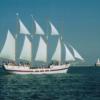
Roger Pellett
-
Posts
4,519 -
Joined
-
Last visited
Reputation Activity
-
 Roger Pellett reacted to guraus in Machine a curer les ports 1750 by guraus (Alexandru) - FINISHED - 1/36
Roger Pellett reacted to guraus in Machine a curer les ports 1750 by guraus (Alexandru) - FINISHED - 1/36
Hello,
More progress pictures.
You will probably notice the knee under the last beam placed on the inside in first 2 pictures - that was a mistake and I took them out since then. In picture number 8 they are on the outside as they should have been in the first place.
I started the small wheel this morning and it is more complicated to build than I expected. I thought that the small one will be easier to do than the big one first but because is small all pieces are thin and break very easily. The two wheels are made from 6 arched pieces each - think I had to cut at least 4 more to replace the broken ones. Plus the horizontal/vertical spokes are square 2mm thick in section and they join at half wood. Those broke a lot too. But in the end I managed to do them and they look quite sturdy now after the full assembly. Quite happy with them.
Alexandru
-
 Roger Pellett got a reaction from PeteB in Endeavour 1934 by Julie Mo - Amati - Scale 1:35 - America's Cup UK J-Class Challenger
Roger Pellett got a reaction from PeteB in Endeavour 1934 by Julie Mo - Amati - Scale 1:35 - America's Cup UK J-Class Challenger
Gold dry transfer letters?
Roger
-
 Roger Pellett got a reaction from Eddie in Endeavour 1934 by Julie Mo - Amati - Scale 1:35 - America's Cup UK J-Class Challenger
Roger Pellett got a reaction from Eddie in Endeavour 1934 by Julie Mo - Amati - Scale 1:35 - America's Cup UK J-Class Challenger
Re: Your concern regarding the transom
Why not paint it, say a semi gloss dark blue (just the transom, not the whole boat!). This would provide a nice contrast with your diagonally planked wooden hull and would provide a great background for lettering. Gold lettering would look good and would be appropriate. Fill it first with a filler that hardens, even Bondo. This will give you another chance to get some sharp well defined edges between transom and hull.
Just an idea.
Roger
-
 Roger Pellett got a reaction from Eddie in Endeavour 1934 by Julie Mo - Amati - Scale 1:35 - America's Cup UK J-Class Challenger
Roger Pellett got a reaction from Eddie in Endeavour 1934 by Julie Mo - Amati - Scale 1:35 - America's Cup UK J-Class Challenger
Diagonal planking is much more common than one might think. The Royal Navy used it extensively in building small boats - their steam pinnacles and picket boats were commonly diagonally planked and there is a 42ft launch from a battle cruiser in the small boat shop at their Portsmouth museum that is diagonally planked. In 1960 my father and I built Thistle class sailboat from a moulded hull built from diagonally laminated layers.
The diagonal planking should have no effect on fluid flow around the hull, positive or negative. First of all, the hull would have been faired longitudinally and with several coats of paint the effect of the diagonal planking would disappear. Typically, there would be two or more layers of planking laid 90 degrees to each other either glued or with a layer of glued fabric between. This would prevent the seams from opening up as with a longitudinally planked hull. Wooden Thistles with their diagonally planked hulls are fully competitive with their moulded fiberglass sisters.
When a boat travels through the water, there is a thin layer of water against the hull moving slowly and parallel to the hull. Outside of this "boundary layer" the water becomes much more disturbed or turbulent. Much of the shear that creates drag is therefore water moving against water. Once the hull is smooth enough that irregularities do not protrude past the thickness of the boundary layer further smoothness is unneccessary. In preparing models for tank testing the University of Michigan hydrodynamics lab painted them with a semi-gloss enamel. The surface of the model was then considered to be hydraulically smooth. The hull of a crack racing yacht would be faired painted and polished to the point that the direction of planking would be immaterial.
Roger Pellett
-
 Roger Pellett reacted to Paul Jarman in Nautical Fiction Writers
Roger Pellett reacted to Paul Jarman in Nautical Fiction Writers
Never read a nautical novel in my life. But being interested in as much as building the kits I decided I would give it a go.
I have just finished reading a none fiction book The Era of the Clipper ship. This was very good and very detailed with info on just about every clipper ever built.
As for the fictional books I have started with the Hornblower series. I am reading Mr Midshipman Hornblower so I can follow him from the start of his carrier. I am only three chapters in and hooked. I will get the whole series. Then I will give some of the other recommendations a go.
Paul
-
 Roger Pellett reacted to PierreJean in Nautical Fiction Writers
Roger Pellett reacted to PierreJean in Nautical Fiction Writers
,
As the title of this thread is "Nautical Fiction Writers" I feel that this is on topic (just). I've read POB, Stockwin, Reeman, all the authors mentioned in the previous posts. They all have their good as well as bad points. It's a matter of taste which you prefer.
Two much more recent nautical books were written by the Dutch writer Jan de Hartog. The one is entitled "Captain" and details the life of a salvage tug during WW2. I found it brilliant, here is a review that I found on Amazon:
" It’s an incredible chronicle of a converted tugboat used to rescue sailors from sunken convoy ships in the North Atlantic in World War II.
More important, it is the story of a man’s growth from innocence to fear to terror to cowardice to finally conscience and understanding of the inhumanity of the wanton, mass destruction of human life in modern warfare. The Captain presents a convincing argument for conscientious objection to war."
The other book loosely connected, is called (here I'm having a senior moment) something Jim (can look it up on Google) but I haven't read that one.
de Hartog wrote a number of other books (not nautical), all worth reading. I think he is a much overlooked writer.
Regards
Pierre
-
 Roger Pellett reacted to ikkypaul in Full-Rigged Sailing Ship by ikkypaul - FINISHED - RESTORATION
Roger Pellett reacted to ikkypaul in Full-Rigged Sailing Ship by ikkypaul - FINISHED - RESTORATION
Build Log
Posting #2
The model: representing a 3 Mast full-rigged ship - square sails on each mast.
Note: scale and all dimensions are estimated
Scale: 1:55
Full size hull length: 55m (190 feet)
Beam: 10.8m (35ft) Mainmast truck to deck: 43m (141ft)
Truck to waterline: 46.75m (153ft)
Truck to Keel 50.6m (167ft)
Main course yard: 21m (68ft)
Sail area: 1,800 sq.m (19,500sq.ft.)
Displacement: 760 tonnes (750 tons)
In the photo below the first thing to note is that the hull is fashioned from a single piece of wood. Reburbishing it involved cutting out most of the original bulwarks, which being made of quite soft wood – probably our native (NZ) white pine – which woodworm (borer) loves! Replacements were made using our NZ Rimu (red pine which was NZ’s main building timber in days gone by) by copying the originals. Of course new pin rails were needed too and rimu was my choice for these. The original belaying pins were simply made from copper wire of the diameter that fitted cosily into the holes.
In this careening position can be seen the remains of the original livery colours. The light grey above the waterline has given the only clue I have as to perhaps the inspiration for this model. Only recently – early 2017 - an acquaintance on seeing my model, exclaimed that the livery was that of the “J.J. Craig Line” of Auckland which operated in the first decade of the 20th Century. So it seems a little more than a possibility that a ship of this line may inspired that young lad, my uncle Julius. Note the keel running the full bilge length – it is solid lead.
Photos below shows readiness for stepping main and mizzen masts, and for that 96 deadeyes were needed.
-
 Roger Pellett reacted to pompey2 in Art of period shipbuilding
Roger Pellett reacted to pompey2 in Art of period shipbuilding
I recall the rope walk in Chatham dockyard, I got to have a go.
And the length of rope I made still hangs above my workbench.
Nick
-
 Roger Pellett got a reaction from Canute in Brigs Niagara and Lawrence
Roger Pellett got a reaction from Canute in Brigs Niagara and Lawrence
If you know someone who has original archival materials from the Browns relative to the construction of the Lake Erie brigs, that would be a major find.
Roger
-
 Roger Pellett got a reaction from thibaultron in Red Bay (Spanish) Galleon
Roger Pellett got a reaction from thibaultron in Red Bay (Spanish) Galleon
In purchasing the five volume set of books about the archaeology excavations at Red Bay in Canada, I wound up with a duplicate copy of Volume III. For modelers this is the best of the five volumes as it contains complete information about the galleon that was recovered and documented. It includes a reconstructed lines drawing as well as longitudinal and cross sections, isometric assembly drawings and details of many parts. An envelope on the back cover includes a separate large scale fold out drawing.
The book measures approximately 8in x 11 in and is 319 pages long. It includes 100's of photos as well as drawings.
The book is brand new, never read, and the galleon is a perfect subject for an accurate model of the period.
i am willing to trade this for a similar maritime history book. Send me a PM if interested.
Roger
-
 Roger Pellett got a reaction from mtaylor in Red Bay (Spanish) Galleon
Roger Pellett got a reaction from mtaylor in Red Bay (Spanish) Galleon
In purchasing the five volume set of books about the archaeology excavations at Red Bay in Canada, I wound up with a duplicate copy of Volume III. For modelers this is the best of the five volumes as it contains complete information about the galleon that was recovered and documented. It includes a reconstructed lines drawing as well as longitudinal and cross sections, isometric assembly drawings and details of many parts. An envelope on the back cover includes a separate large scale fold out drawing.
The book measures approximately 8in x 11 in and is 319 pages long. It includes 100's of photos as well as drawings.
The book is brand new, never read, and the galleon is a perfect subject for an accurate model of the period.
i am willing to trade this for a similar maritime history book. Send me a PM if interested.
Roger
-
 Roger Pellett got a reaction from Eddie in Mandatory - for sellers new to MSW (model builders or commercial retailers)
Roger Pellett got a reaction from Eddie in Mandatory - for sellers new to MSW (model builders or commercial retailers)
Can I offer something for trade?
Roger
-
 Roger Pellett got a reaction from mtaylor in Wood for large solid hull
Roger Pellett got a reaction from mtaylor in Wood for large solid hull
50 years ago the wood of choice of professional model builders carving models for the University of Michigan's ship model towing tank (now called their Marine Hydrodynamics Lab) was "pattern makers pine." This stuff came in beautiful, long, clear, straight grained lengths. The models towed in the tank were large- 8 or so feet long. Today, the models are styrofoam core fiberglass made by outside contractors.
So what is pattern makers pine? One Internet site that I looked at said that Northern White Pine was used for patterns. This is the stuff being recovered from the bottom of Lake Superior near Bayfield WI. Living in Maine and Illinois you should be able to find some at a small mill.
The other possibility would be western Sugar Pine. Our local Menards store has been carrying some nice 5/4 lumber that I believe is sugar pine.
The preferred way to build a large solid hull is from laminations to minimize chances for warping and cracking.
Roger
-
 Roger Pellett got a reaction from mtaylor in Mandatory - for sellers new to MSW (model builders or commercial retailers)
Roger Pellett got a reaction from mtaylor in Mandatory - for sellers new to MSW (model builders or commercial retailers)
Can I offer something for trade?
Roger
-
 Roger Pellett got a reaction from Tadeusz43 in USS CAIRO by Gerhardvienna - RADIO - live steam
Roger Pellett got a reaction from Tadeusz43 in USS CAIRO by Gerhardvienna - RADIO - live steam
The whole subject of US Navy ships boats supplied to the fleet prior to 1900 is a bit of a black hole. Prior to the late 1890's ships boats were not standardized, being designed by the boat shops at each navy yard. The boats from Chapelle's book were designed at the Washington Navy Yard and those for Jerry Todd's Constellation at the Norfolk Navy Yard. There are boat allowances that at least specify overall dimensions for boats allowed to be carried by different classes. See, for example, William Brady's Kedge Anchor. A 26ft launch is to have a breadth of 7.4ft and a depth of 3.4ft. A 26ft cutter a breadth of 6.6ft and a depth of 2.4ft (this dimension might not include the cutter's wash strake). Complicating this fact is that we don't know where the boats for the river gunboats came from. Were they built at St Louis or were they supplied by one of the Navy yards? Additionally complicating things is the fact that the gunboat fleet was originally controlled by the Army, later transferred to the Navy. Boats were subject to hard usage and were always being knocked about, so the lifetime of an individual boat might have been short.
I thought that you might enjoy photos of a 26ft cutter and a boat howitzer that I built for my 1:96 scale model of the monitor USS Catskills.
-
 Roger Pellett reacted to Pete Jaquith in How to chisel a solid hull boat
Roger Pellett reacted to Pete Jaquith in How to chisel a solid hull boat
Chuck,
When carving the lower hull I secure the hull block to a reference board that provides a common baseline for station/profile templates. Shaping of decks and bulwarks is performed in a cradle that supports the model with the waterline level.
Regards,
Pete
-
 Roger Pellett reacted to dvm27 in Speedwell 1752 by dvm27 (Greg Herbert) - FINISHED - Ketch Rigged Sloop
Roger Pellett reacted to dvm27 in Speedwell 1752 by dvm27 (Greg Herbert) - FINISHED - Ketch Rigged Sloop
It was pointed out to me by the ever-observant Druxey that the lower chocks of my capstan were incorrectly shaped. The should indeed be concave. I was misled by some contemporary sources. After a short alcohol soak and they were removed and replaced with the proper shaped chocks. Also, a photo of my now pristine workshop (after an entire evening of cleaning). My new mantra - replace tools right after using them....(at least for a day or so).
Thanks for all the like. David Antscherl is doing his part for the publication of the Speedwell book. I just need to catch up
-
 Roger Pellett got a reaction from tadheus in USS CAIRO by Gerhardvienna - RADIO - live steam
Roger Pellett got a reaction from tadheus in USS CAIRO by Gerhardvienna - RADIO - live steam
The whole subject of US Navy ships boats supplied to the fleet prior to 1900 is a bit of a black hole. Prior to the late 1890's ships boats were not standardized, being designed by the boat shops at each navy yard. The boats from Chapelle's book were designed at the Washington Navy Yard and those for Jerry Todd's Constellation at the Norfolk Navy Yard. There are boat allowances that at least specify overall dimensions for boats allowed to be carried by different classes. See, for example, William Brady's Kedge Anchor. A 26ft launch is to have a breadth of 7.4ft and a depth of 3.4ft. A 26ft cutter a breadth of 6.6ft and a depth of 2.4ft (this dimension might not include the cutter's wash strake). Complicating this fact is that we don't know where the boats for the river gunboats came from. Were they built at St Louis or were they supplied by one of the Navy yards? Additionally complicating things is the fact that the gunboat fleet was originally controlled by the Army, later transferred to the Navy. Boats were subject to hard usage and were always being knocked about, so the lifetime of an individual boat might have been short.
I thought that you might enjoy photos of a 26ft cutter and a boat howitzer that I built for my 1:96 scale model of the monitor USS Catskills.
-
 Roger Pellett got a reaction from Canute in Wood for large solid hull
Roger Pellett got a reaction from Canute in Wood for large solid hull
50 years ago the wood of choice of professional model builders carving models for the University of Michigan's ship model towing tank (now called their Marine Hydrodynamics Lab) was "pattern makers pine." This stuff came in beautiful, long, clear, straight grained lengths. The models towed in the tank were large- 8 or so feet long. Today, the models are styrofoam core fiberglass made by outside contractors.
So what is pattern makers pine? One Internet site that I looked at said that Northern White Pine was used for patterns. This is the stuff being recovered from the bottom of Lake Superior near Bayfield WI. Living in Maine and Illinois you should be able to find some at a small mill.
The other possibility would be western Sugar Pine. Our local Menards store has been carrying some nice 5/4 lumber that I believe is sugar pine.
The preferred way to build a large solid hull is from laminations to minimize chances for warping and cracking.
Roger
-
 Roger Pellett got a reaction from John Allen in Wood for large solid hull
Roger Pellett got a reaction from John Allen in Wood for large solid hull
50 years ago the wood of choice of professional model builders carving models for the University of Michigan's ship model towing tank (now called their Marine Hydrodynamics Lab) was "pattern makers pine." This stuff came in beautiful, long, clear, straight grained lengths. The models towed in the tank were large- 8 or so feet long. Today, the models are styrofoam core fiberglass made by outside contractors.
So what is pattern makers pine? One Internet site that I looked at said that Northern White Pine was used for patterns. This is the stuff being recovered from the bottom of Lake Superior near Bayfield WI. Living in Maine and Illinois you should be able to find some at a small mill.
The other possibility would be western Sugar Pine. Our local Menards store has been carrying some nice 5/4 lumber that I believe is sugar pine.
The preferred way to build a large solid hull is from laminations to minimize chances for warping and cracking.
Roger
-
 Roger Pellett reacted to michael mott in Bristol Pilot Cutter by michael mott - 1/8 scale - POF
Roger Pellett reacted to michael mott in Bristol Pilot Cutter by michael mott - 1/8 scale - POF
Denis , Elmer , and Piet thanks for the kind remarks.
Did a bit more work cleaning up the compass and made the cover from some 1/32 plexiglass.
The bolts are some modified 00x90 1/4 in long hex bolts.
After cutting them to length and polishing the threaded end they were held in the pin chuck to reduce the hight of the head and to round it up a bit.
All the gimbal rings were given a final sanding with some 1200 grit wet and dry.
and fitted back into the copper dome.
Michael
-
 Roger Pellett reacted to KeithAug in Altair 1931 by KeithAug - FINISHED - Scale 1:32 - schooner
Roger Pellett reacted to KeithAug in Altair 1931 by KeithAug - FINISHED - Scale 1:32 - schooner
Michael - surprisingly I had passingly thought about it and got as far as thinking about a machining set up. I sort of wanted a tilting dividing head to make it easy but I don't have one. Anyway it seemed like a lot of work. I might have had a go if the number of components had been less but machining up 30 rings seemed to be a bit of a chore. I find the fun is in working out how to make something - not making loads of the same thing.
By the way the Bristol Channel can be very choppy and I do think you need to damp that compass needle if you are intent on steering a true course.
-
 Roger Pellett got a reaction from Elijah in USN Picket Boat #1 by GuntherMT - Model Shipways - scale 1:24
Roger Pellett got a reaction from Elijah in USN Picket Boat #1 by GuntherMT - Model Shipways - scale 1:24
Does anyone who has built this Model or is otherwise interested in the subject understand why the kit manufacturer chose the to show this boat with a round stern? Existing contemporaneous drawings show these craft with square sterns.
Roger
-
 Roger Pellett got a reaction from Canute in USN Picket Boat #1 by GuntherMT - Model Shipways - scale 1:24
Roger Pellett got a reaction from Canute in USN Picket Boat #1 by GuntherMT - Model Shipways - scale 1:24
Does anyone who has built this Model or is otherwise interested in the subject understand why the kit manufacturer chose the to show this boat with a round stern? Existing contemporaneous drawings show these craft with square sterns.
Roger
-
 Roger Pellett got a reaction from Ryland Craze in USN Picket Boat #1 by GuntherMT - Model Shipways - scale 1:24
Roger Pellett got a reaction from Ryland Craze in USN Picket Boat #1 by GuntherMT - Model Shipways - scale 1:24
Does anyone who has built this Model or is otherwise interested in the subject understand why the kit manufacturer chose the to show this boat with a round stern? Existing contemporaneous drawings show these craft with square sterns.
Roger










